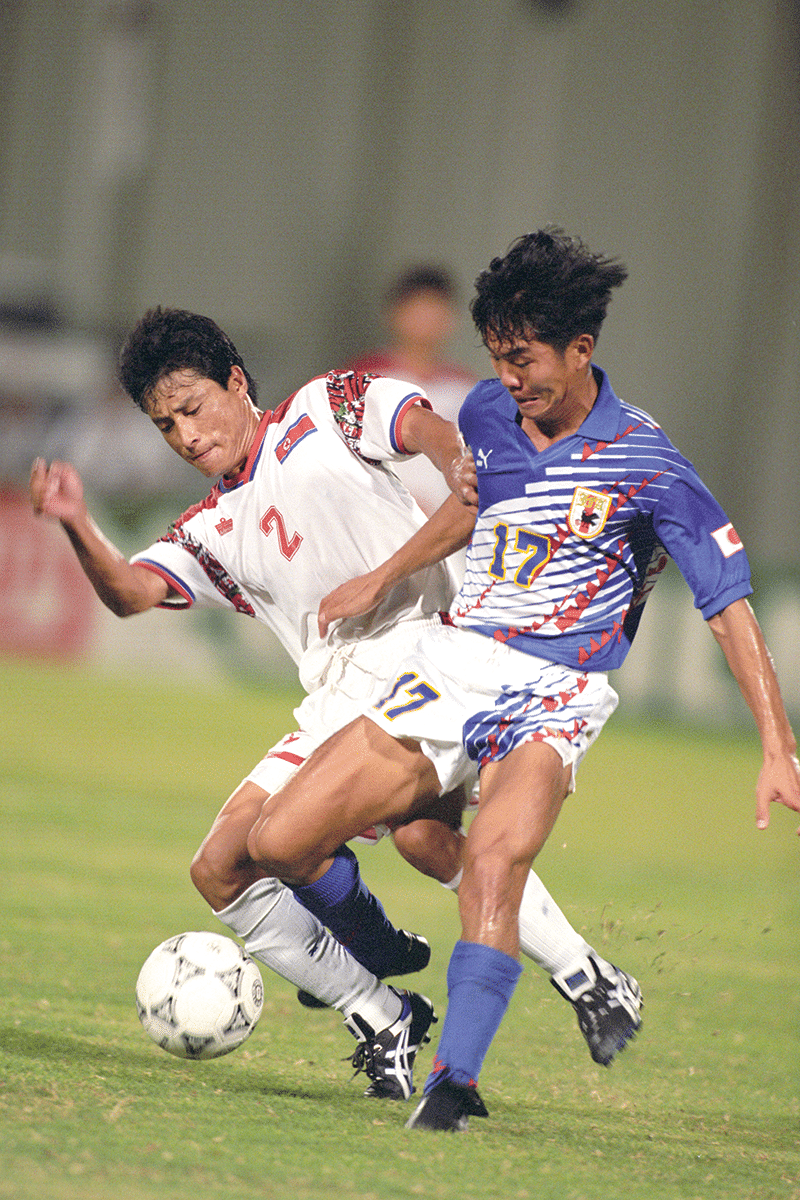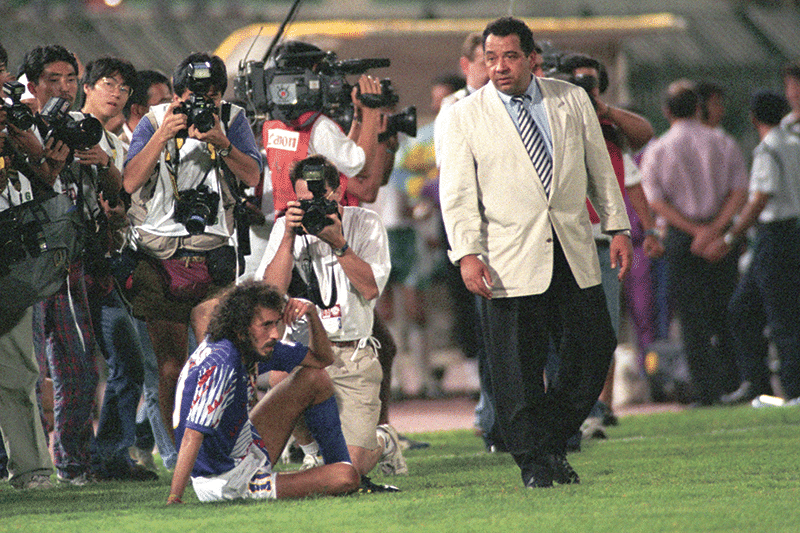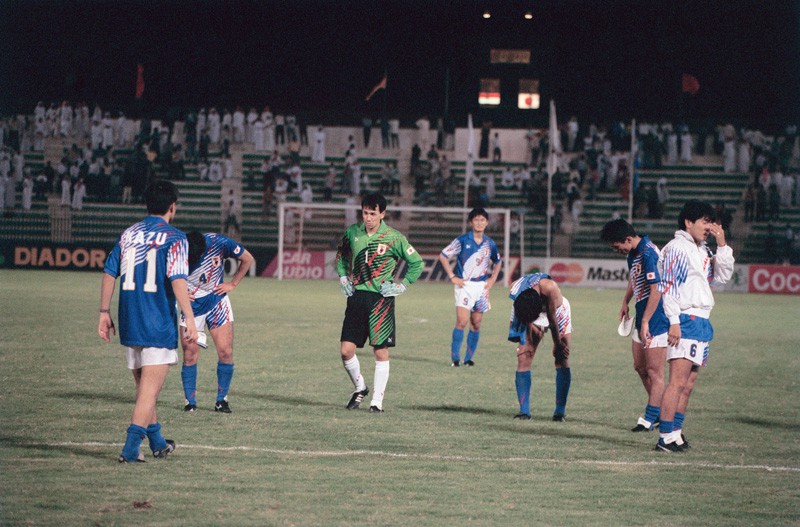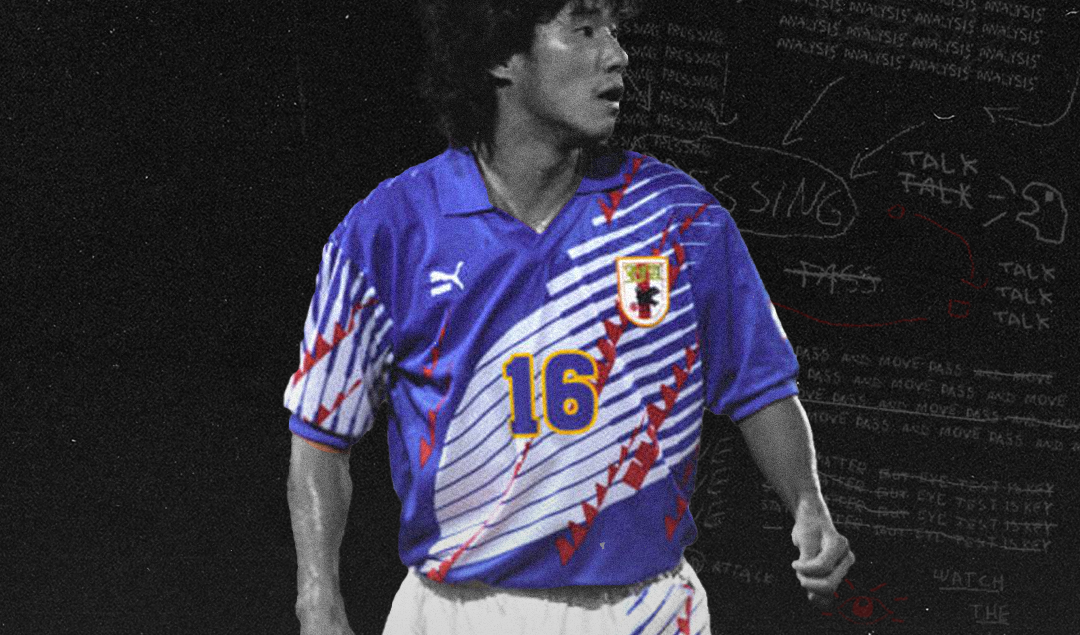The Agony of Doha: When Iraq Snatched Glory From Japan’s Palms
Japan are known today as one of the giants in Asian football, their players grace Europe’s top leagues, with their domestic clubs winning Asian Champions League titles on multiple occasions and the national team is widely respected for their technical prowess on the ball.
Yet the reputation Japan have cemented on the football stage was not borne out of triumph on the field like the nations of Brazil, Italy, Germany or Uruguay. Instead, their achievements would be inspired out of heartbreak and agony 27 years ago.
1993 was an important year for Japanese domestic football with the introduction of the J-League in May. The desire of the Japan Football Association (JFA) for a professional league was part of a concerted plan to host the 2002 World Cup. Heavy investment ranging into billions of yen, slick marketing from the media and bringing in foreign stars like Gary Lineker, Ramón Diaz and Pierre Littbarski led to the success of the league during its inaugural season.

Photo: PES Miti Del Calcio
The growing success of the J-League heightened the national team’s attempts to qualify for the 1994 World Cup in America. By the autumn, Japan had progressed into the second and final qualifying stage.
With the J-League attracting new fans in its debut season, progressing to the country’s first ever World Cup was an opportunity for the game in Japan to grow exponentially. The prospect of additional revenue in new sponsors or investment was a tantalising scenario for the JFA.
The format of the final qualifying stage in Asia back then was very different compared to those in Europe, Africa or South America. It consisted of six teams in a single group that played each other once. Furthermore, all of the fixtures would be hosted by Qatar and played during a two week period starting from mid-October. The top two sides in the group would qualify for the 1994 World Cup.
Japan’s opponents in the group were Iran, Iraq, North Korea, Saudi Arabia and South Korea. Managed by Dutchman Hans Ooft, he guided the Samurai Blue to their first ever Asian Cup a year earlier. Under such growing optimism, the qualifiers presented a chance to do what no Japanese side had done before.
More importantly, for veteran players like goalkeeper Shigetatsu Matsunaga, defender Masami Ihara midfielder Ryu Ramos, forward Kazuyoshi Miura and skipper Tetsuji Hashiratani it could be their last opportunity to play in a World Cup. In addition, winning the Asian Cup had inflated the expectations of Japanese fans, resulting in thousands flocking to Doha to see what they felt would be a defining moment for Japanese football.
Japan’s opening game in the group was against Saudi Arabia in Doha on the 15th October – whom they defeated 1-0 in the final to lift the Asian Cup. Two of the continent’s best sides would cancel each other out in a goalless draw, Japan’s potent strike force of Miura and Masashi Nakayama blunted.

Photo: The AFC
A point in their first game was no disaster for Japan, but it was hoped they could lay a marker in their next fixture against Iran three days later.
Iran had identified Ruy Ramos as the main threat, planning to cut the supply to Japan’s main strikers Miura and Nakayama so to nullify their attack. The implementation of their strategy was crude yet effective – Ramos well marshaled by fair means or foul.
Limiting the Japanese to a few chances allowed Iran to impose themselves into the game. They crucially took the lead before half time when defender Reza Hassanzadeh headed a cross from the right into the far corner of the net.
Now a goal down, Japan tried to push forward in search of an equalizer in the second half. Yet chances were few and far between, the shackling of Ramos denying them momentum. The only real opportunity for Japan to get into the game was from errors and their best chance came when Iran’s goalkeeper spilled the ball from a corner, but forward Masahiro Fukuda’s effort from close range was deflected over the bar.
Iran would kill the game off with five minutes remaining. Excellent footwork from Iran’s Sirous Ghayeghran near the left sided touchline allowed him to get past two players and then thread a pass to young striker Ali Daei who broke the offside trap. With Japan caught out playing a very high line, Matsunaga rushed out towards Daei yet got nowhere near the striker. Daei simply went past the goalkeeper and put the ball into the net to double Iran’s lead.

Photo: The AFC
Hopes were raised when Japan pulled a goal back a few minutes later through Nakayama but Iran held on to win the game. Speaking to James Montague in the Blizzard five years ago, Ooft was forthright in the main factor behind their defeat to Iran:
“The second match against Iran they went for our playmaker Ruy Ramos. They kicked him whenever and wherever they could so we lost.”
Losing to Iran meant Japan now lingered at the bottom of the group alongside Iraq with just one point won out of a possible four. Each of the next three games was crucial for Ooft, as well as his players, starting with North Korea three days later.
Quiet against Iran, Ramos was able to dictate the play against North Korea, as a rejuvenated Japanese side played on the front foot. Their enterprising play was rewarded by Miura heading in Ramos’ lofted cross from a free kick. Ramos displayed his creativity later in the first half with an expertly weighted cross with his right foot only for Nakayama to hit the post.
Japan took control of the game six minutes into the second half by doubling their lead. Receiving the ball on the right in an advanced position, Miura’s first time cross found his fellow striker Nakayama who lashed the ball home from close range. The Samurai Blue got their third goal on 69 minutes when Ramos got his second assist of the game after Miura met his delivery from a corner with a fierce volley.
Such a resounding victory gave Japan much needed confidence heading into the final two games, with all of the six teams still having a chance of qualifying. South Korea and Saudi Arabia occupied the qualifying spots with four points each.

Photo: Neal Simpson – EMPICS
Japan were third place with three points, with Iraq having the same amount of points as the Japanese, but were fourth due to an inferior goal difference. Meanwhile, Iran and North Korea propped up the rear on two points. Japan’s penultimate game on the 24th October was against South Korea.
The match between such rivals was given added importance due to Saudi Arabia being held 1-1 against Iraq 24 hours earlier. Japan began the game brightly and nearly scored when Ihara met Nakayama’s deep cross at the back post with a rasping volley that was parried onto the post by veteran goalkeeper and captain Choi In-Young.
With the score level as the game wore into the second half, the deciding moment came on the 61st minute when a cross from the left wasn’t properly dealt with by the South Korean defence and Miura stabbed home from less than four yards out.
South Korea poured forward in search for an equaliser but could only create just one real chance – when Ha Seok-Ju found himself in some space inside the box only for his low shot ably stopped by the left leg of goalkeeper Matsunaga.
Japan held on to narrowly beat South Korea and the palpable relief on the looks of players and the coaching staff was notable. Heading into the final round of matches, five teams were still in contention to qualify for the World Cup. Japan and Saudi Arabia both had six points, while South Korea, Iraq and Iran had four points each.
Having been already eliminated, North Korea were bottom with two points. The final round of matches on the 28th October were to be played simultaneously across three stadiums in Doha. Saudi Arabia played Iran, South Korea had a cross border derby against North Korea and Japan faced Iraq.
A win for Japan would clinch qualification to the World Cup. A draw would be enough if South Korea and Saudi Arabia failed to win. A draw could mean elimination if both Saudi Arabia and South Korea won. Defeat meant certain elimination for the Samurai Blue if South Korea won and whoever won between Saudi Arabia and Iran. It was make or break time for Japan’s players and especially Ooft.

Photo: Etsuo Hara
The importance of such a game culminated in a dream start for Japan within the first five minutes. Making a run deep into Iraq’s half, forward Kenta Hasegawa played the ball to Nakayama on the right. Controlling the ball before turning past his marker, Nakayama laid the ball to Hasegawa who had continued his run into the 18 yard box.
Hasegawa’s first time shot rattled the crossbar but Miura was alert enough to head the rebound into the empty net to give Japan the lead. Cometh the hour, cometh the man Japan fondly named “King Kazu.”
Japan controlled the game in the first half and led at half time. The scores in the other games benefited Japan as South Korea were being held 0-0 by North Korea and Saudi Arabia were beating Iran 2-1. Ooft’s side were going through to the World Cup as things stood.
However, as the game entered into the second half, Japan slowly began to get nervous and Iraq took the game to their opponents after a lacklustre first half. They began to ratchet up the pressure, having a goal disallowed for offside serving as a warning to Japan. The Samurai Blue would not heed it, as Iraq turned pressure into a goal just nine minutes into the second half, captain Ahmed Radhi scrappily scoring from close range.
Frayed nerves would turn into euphoria for Japan with just 20 minutes to go, as Ramos played in Nakayama to break the offside trap and slot the ball past Iraqi goalkeeper Ibrahim Salim.

Photo: Weekly Soccer Digest
Now Japan had the momentum with time ticking away into stoppage time, but news began to trickle in regarding the other games. South Korea had scored a flurry of goals to lead 3-0 against North Korea while Saudi Arabia were beating Iran 4-3.
With the game entering the 90th minute, Iraq won a corner on the right. As things stood, Japan were on their way to the World Cup. Laith Hussain played a short pass to Alaa Khadim who glided past his marker to cross the ball into the box. Substitute Jaffar Omran reacted quickest at the near post and glanced a header past Mastunaga into the far corner of the net. The hopes and dreams of a footballing nation were shattered in a matter of seconds.
Success wilting away into failure like autumn leaves, one Japanese player in the box slumped to the ground, then another and then a third. Ruy Ramos booted the ball away in anger as they prepared to restart the game. Once they did, the referee from Switzerland blew his whistle for full-time.
Several Japanese players collapsed to the ground in shock – their faces one of hurt and disbelief at what had occurred. Ooft could only stare blankly at his players lying devastated on the turf, while those Japanese fans in the stands looked on in stunned silence.

Photo: Jiji Press
Meanwhile, South Korea’s players celebrated wildly at finding out what happened, knowing they alongside Saudi Arabia have qualified for the 1994 World Cup. The words of midfielder Hajime Moriyasu illustrated the feelings of Japan’s players after what had occurred:
“I can’t remember the changing room after the game, or speaking to the media afterward, or the bus ride back to the hotel. I had devoted myself to my World Cup dream.
We had so many training camps that I spent more time with my team-mates than with my family. I could see the World Cup right in front of me but when I went to grab it, it vanished into thin air.”
The events of the 28th October would be known as the Miracle Of Doha in South Korea. In Japan, that day would be known as the Agony Of Doha.
Agony for Ooft, sacked just a few weeks after the end of the qualifiers. Agony for several of Japan’s veteran players who would retire from international football or be dropped from the nation squad. Agony for those Japanese fans in Doha and those watching at home whose hopes were cruelly dashed in an instant. Agony came in June when South Korea began their World Cup with a battling 2-2 draw against Spain.

Photo: Getty
Nevertheless, from agony rose a sense of determination in Japan – a desire to learn from the heartbreak of Doha and make sure these mistakes were not repeated. A rocky start to qualifying for the 1998 World Cup led to the sacking of manager Shu Kamo in October 1997.
On the other hand, Kamo’s replacement Takeshi Okada was able to guide the Samurai Blue to victory in their last group games (under a different format that continues to this day) and qualify for their very first World Cup. Just two players from the side that participated in the Agony Of Doha, Ihara and Nakayama, would feature at the tournament in France.
Yet from the agony of failure led to Japan’s building blocks as one of Asia’s footballing giants. Since that fateful late October night the Samurai Blue have never failed to qualify for the World Cup.
By: Yousef Teclab
Featured Image: @GabFoligno
